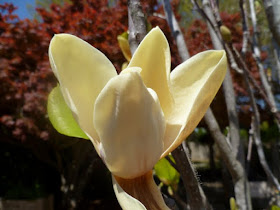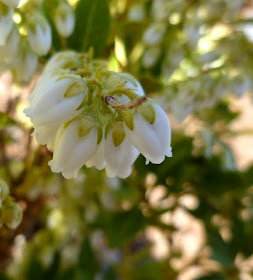Yes, I realize many of you are looking for this week's tree posting. Let's just say that a lovely day got the better of me. We have had much needed rain for the last few days and today--THE SUN WAS SHINING! I called one of my neighbors and we went over to Park Seed Company/Wayside Gardens. This lovely Japanese Maple was just shimmering with its spring apricot colors.
The Trial Gardens are getting prepped for the new year's trial plantings. Surrounding the garden beds are some wonderful garden areas. There is a Ornamental Grass and Its Companions garden, a Rose Garden, a Deer Resistant Garden, a Winter Interest Garden.....all sorts of great plants to enjoy.
I love the River Birch in the foreground and the Redbud down near the garden trial beds. There are some mature trees through this garden and add much needed shade come June and the Festival of Flowers. The Festival of Flowers is a month long celebration in Greenwood, SC that has many activities throughout the month. Check out the link and see all the wonderful gardening events there are for this festival. Today the gardens were quiet, relaxing and an enjoyable place to spend a little time.
Doesn't this yellow Magnolia look lovely? I asked inside about the name of this one, but since there was no longer a name tag, they were unsure. I am hoping it is Magnolia 'Elizabeth'. (more about that later)
There were a couple different varieties of Cercis in bloom. What a color!! I love it. The blue sky was the perfect backdrop to this magenta bloom.
So many trees and plants budding out, love the yellow foliage on this Dawn Redwood. With a name like 'Gold Rush' one would believe it will stay yellow.
 You would not believe how large this Bleeding Hearts plant was-- I would estimate it was about 24 inches tall and equally wide. It was impressive.
You would not believe how large this Bleeding Hearts plant was-- I would estimate it was about 24 inches tall and equally wide. It was impressive.In addition to the pink of the Bleeding Hearts there was a glorious display from a Flowering Cherry. I couldn't find the tag for this one, so it will just be labeled 'Flowering Cherry'.
I love the foliage of this Hydrangea, believe it is H. quercifolia 'Little Honey' .....the yellow echoes the yellow in the center of these Primroses. The photo doesn't do it justice.
As we were leaving we checked out the large shade loving plants against the building. A large (about 8- 10 feet tall) deciduious azalea was just getting ready to open... alas, no fragrance.
Rest assured my fellow garden friends.....I did not come home empty handed!! As Park Seed was having a special on Hemerocallis, I bought 10 of them and a few other things as well......
©Copyright 2011 Janet. All rights reserved. Content created by Janet for The Queen of Seaford.



























































